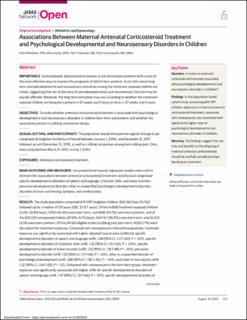| dc.description.abstract | Importance Corticosteroids administered to women at risk of imminent preterm birth is one of the most effective ways to improve the prognosis of infants born preterm. Scant data about long-term neurodevelopmental and neurosensory outcomes among the treatment-exposed children are mixed, suggesting that not all domains of neurodevelopmental and neurosensory function may be equally affected. Moreover, the long-term outcomes may vary according to whether the treatment-exposed children are being born preterm (<37 weeks and 0 days) or term (≥37 weeks and 0 days).
Objectives To study whether antenatal corticosteroid treatment is associated with psychological developmental and neurosensory disorders in children born term and preterm and whether the associations persist in a sibling-comparison design.
Design, Setting, and Participants This population-based retrospective register-linkage study comprised all singleton live births in Finland between January 1, 2006, and December 31, 2017, followed up until December 31, 2018, as well as a sibling comparison among term sibling pairs. Data were analyzed from March 21, 2021, to July 7, 2022.
Exposures Antenatal corticosteroid treatment.
Main Outcomes and Measures Cox proportional hazards regression models were used to estimate the associations between antenatal corticosteroid treatment and physician-diagnosed specific developmental disorders of speech and language, scholastic skills, and motor function; pervasive developmental disorder; other or unspecified psychological developmental disorder; disorders of vison and hearing; epilepsy; and cerebral palsy.
Results The study population comprised 670 097 singleton children (342 562 boys [51.1%]) followed up for a median of 5.8 years (IQR, 3.1-8.7 years). Of the 14 868 treatment-exposed children (2.2%; 53.9% boys), 6730 (45.3%) were born term, and 8138 (54.7%) were born preterm, and of the 655 229 nonexposed children (97.8%; 51.1% boys), 634 757 (96.9%) were born term, and 20 472 (3.1%) were born preterm. Of the 241 621 eligible maternal sibling pairs born term, 4128 (1.7%) were discordant for treatment exposure. Compared with nonexposure in the entire population, treatment exposure was significantly associated with higher adjusted hazard ratios (aHRs) for specific developmental disorders of speech and language (aHR, 1.38 [95% CI, 1.27-1.50]; P < .001), specific developmental disorders of scholastic skills (aHR, 1.32 [95% CI, 1.13-1.54]; P = .004), specific developmental disorder of motor function (aHR, 1.32 [95% CI, 1.18-1.49]; P < .001), pervasive developmental disorder (aHR, 1.35 [95% CI, 1.17-1.56]; P < .001), other or unspecified disorder of psychological development (aHR, 1.88 [95% CI, 1.58-2.25]; P < .001), and vision or hearing loss (aHR, 1.22 [95% CI, 1.04-1.43]; P = .02). Compared with nonexposure in the term-born group, treatment exposure was significantly associated with higher aHRs for specific developmental disorders of speech and language (aHR, 1.47 [95% CI, 1.31-1.66]; P < .001), specific developmental disorders of scholastic skills (aHR, 1.28 [95% CI, 1.01-1.63]; P = .04), specific developmental disorder of motor function (aHR, 1.38 [95% CI, 1.12-1.70]; P < .001), pervasive developmental disorder (aHR, 1.42 [95% CI, 1.16-1.75]; P < .001), other or unspecified disorder of psychological development (aHR, 1.92 [95% CI, 1.51-2.43]; P < .001), epilepsy (aHR, 1.57 [95% CI, 1.22-2.01]; P < .001), and cerebral palsy (aHR, 2.18 [95% CI, 1.47-3.23]; P < .001). The hazard for any psychological developmental and neurosensory disorder was significantly higher for the treatment-exposed sibling compared with the nonexposed cosibling (absolute difference, 1.2% [95% CI, 0.03%-2.4%]; P < .001; aHR, 1.22 [95% CI, 1.04-1.42]; P = .01). Antenatal corticosteroids were not associated with either significant benefit or risk in the preterm group.
Conclusions and Relevance This study suggests that the possible long-term psychological developmental and neurosensory harms warrant careful consideration of risks and benefits when deciding on maternal antenatal corticosteroid treatment. | en_US |

